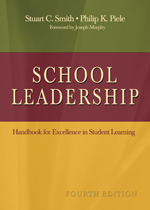Joseph Murphy
Foreword
Preface
How This Book Was Written
Acknowledgments
About the Editors
About the Contributors
Introduction: Leadership for Excellence in Learning
The Mission Is Student Learning
Assumptions About the Nature of Leadership
Conclusion: A Passion for Learning
PART I. The State of School Leadership
Larry Lashway
1. The Landscape of School Leadership
The State of the Principalship: A Snapshot
The Supply and Demand Challenge
What Is the Principal’s Proper Role?
Conclusion: What’s Over the Next Hill?
Larry Lashway
2. The Effects of Leadership
The Search for Leadership Effects
Syntheses of the Evidence
Essential Acts of Leadership
Conclusion: A Compass, Not a Road Map
PART II. The Person
Larry Lashway, JoAnn Mazzarella, and Thomas Grundy
3. Portrait of a Leader
The Characteristics of Leaders
The Genesis of Leadership
What We Don’t Know About Leadership
Conclusion: A Sketch for Each Leader to Complete
Larry Lashway
4. Leadership Styles and Strategies
Dimensions of Leadership Style
Unanswered Questions About Style
Transformational Leadership
Is There a Best Strategy?
Conclusion: The Need for Clarity of Purpose
Larry Lashway
5. Developing School Leaders
A Developmental Perspective
The Phases of Principals’ Careers
The Special Case of the Assistant Principal
Assessment Tools for Developing Leadership
Conclusion: A Pathway Uncertain Yet Sure
PART III. The Values
Larry Lashway
6. Ethical Leadership
Conclusion: A Question of Destiny
Larry Lashway
7. Visionary Leadership
Developing Personal Vision
Tailoring the Vision to the School
Institutionalizing the Vision
Beyond Vision: The Learning Organization
Conclusion: Change as a Driving Force for Excellence
Stuart C. Smith
8. Cultural Leadership
The Power of a Strong Culture
The Perspective of This Chapter
Principles for Shaping School Culture
How Leaders Construct Culture
Shaping the Student Subculture
Fostering a Sense of Community
Conclusion: Having the Heart to Persevere
Larry Lashway
9. Accountable Leadership
The Many Faces of Accountability
Using Accountability to Improve Learning
Conclusion: A Core Leadership Responsibility
Wendell Anderson
10. Site-Based Management
History and Structure of SBM
SBM and Academic Achievement
Role of the Principal in SBM
Role of the Superintendent and Other Administrators
Conclusion: Leaders’ Commitment Drives Change
Larry Lashway
11. Distributed Leadership
Who Was That Masked Man, Anyway?
An Alternative Conception: Distributed Leadership
The Continuum of Leadership
Distributed Leadership in Schools
Varieties of Distributed Leadership
Making Distributed Leadership Work
Expanding Leadership Through Work Teams
Conclusion: Why the Effort Is Worthwhile
Larry Lashway
12. Political Leadership
The Two Worlds of School Politics
Conclusion: Being Political, Remaining Ethical
PART V. The Mission: Student Learning
Ronald A. Beghetto and Julie Alonzo
13. Instructional Leadership: Supporting the Learning Process
Clarifying the Goals of Purposeful Learning
Selecting Instructional Strategies
Conclusion: Collaboration Is the Route to Success
Ronald A. Beghetto and Leanne R. Ketterlin-Geller
14. Instructional Leadership: Progress Monitoring
What Is Progress Monitoring?
Using Multiple Sources of Information to Monitor Progress
Improving the Interpretation and Use of Information
An Example: Progress Monitoring in a School District
Conclusion: A Career-Long Practice
Ronald A. Beghetto
15. Instructional Leadership: Cultivating a Learning-Focused Community in Schools
What Is a Learning-Focused Community?
Why Do Students Engage in or Avoid Achievement-Directed Behavior?
How Do Learning Communities Influence Students’ Achievement Behavior?
How Does the Learning Environment Influence Teachers?
Cultivating a Focus on Learning in the School Community
Conclusion: The Need for Creativity and Resolve
PART VI. The Skills
Wendell Anderson
16. Communicating
Principles of Organizational Communication
Communication and Student Learning
The Communication Process
Conclusion: Perseverance Pays Off
Wendell Anderson
17. Engaging the Public
A New Way of Doing Business
Connecting With the Community
Creating a Community-Relations Plan
Working With the News Media
Evaluating Community-Relations Efforts
Conclusion: Engaging for Mutual Benefit
Gerald Tindal, Luke Duesbery, and Leanne R. Ketterlin-Geller
18. Managing Data for Decision Making: Creating Knowledge From Information
Principles of Data-Driven Decision Making
Developing an Infrastructure for Managing and Interpreting Data
Getting Accurate Data From All Students: Technical Adequacy and Universal Design
Reference for Interpreting Results: Using Graphic Displays to Evaluate Performance
Conclusion: The Goal Is Progress for All Students
Faith E. Crampton and Randall S. Vesely
19. Allocating Human, Financial, and Physical Resources
Human Resources: Creating and Sustaining Human and Social Capital
Fiscal Resources: Making the Best Use of Existing Financial Resources
Physical Resources: Maintaining and Enhancing the Physical Environment of Schools
Conclusion: Comprehensive Planning Is Best Practice
References
Index
